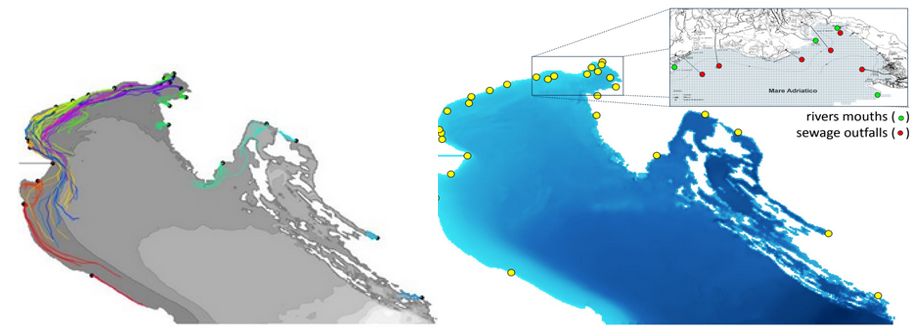3D Lagrangian model to track fate and transport of plastic particles in the northern Adriatic Sea with a particular focus on physical and biogeochemical processes
Ocean Sciences, Modeling
Research area
The research focuses on the transport and fate of plastic particles in the Northern Adriatic Sea using a 3D Lagrangian model. Since one of the main unknowns about plastic at sea is that there is a huge discrepancy between the estimated plastic pollution entering the ocean and the actual amount detected at the sea surface, this analysis aims to investigate processes that influence the transport of plastic debris in the marine environment to estimate their potential contribution in moving them away from the sea surface. The approach used consists of the combination of two different modeling studies: the transport of microplastic (considered as a passive tracer) by currents and winds, in order to identify advection patterns and accumulation points, combined with the processes that rule the interaction of microplastic with micro-organisms (phyto and zooplankton) living in the sea, that contribute to the sinking of the microplastics.
Project goals
The topic of the project consists of three different thematic areas: - The tracking of particles resulting from the offline coupling between the Eulerian model MITgcm, used to produce the hydrodynamic fields, and the Lagrangian model LTRANS computing the particle trajectories, forced by the MITgcm’s fields. - The modelling of the areas of influence of the sources of plastic pollution in the domain, considering river mouths and wastewater treatment plants, consisting of the continuous release in time of 1,140,244 particles, during 4 years, each of them followed for one year, covering a total period of 5 years (2017-2021). - Definition of the role of microorganisms responsible for moving plastic away from the surface by inducing changes in buoyancy. Two processes are being analyzed,the biofouling and the fecal pellet egestion. The former consists of the colonization of particles by algae, while the latter consists of the ingestion of plastic by zooplankton individuals and consequent egestion of plastic packed into fecal pellets.
Computational approach
The topic of the project is the construction of a 3D model composed by the coupling of three existing models: the physical model MITgcm, a biogeochemical model producing the phyto and zooplankton fields, both coupled offline to the lagrangian model LTRANS Zlev. The latter computes the trajectories of each particle advected by the physical fields combined with phyto and zoo-plankton fields, both responsible for the sinking of particles that would have been floating in absence of these interactions. The steps to perform this analysis are:
- Identify the main sources of pollutants and quantify their contribution to the injection of microplastic at sea.
- Setting LTRANS simulations to track particle trajectories, where particles are treated as a passive tracer, to identify patterns in their dynamics and accumulation areas.
- Development of the 1D model of the interaction between plastic and microorganisms.
- Integrate the 1D model into the lagrangian model.
The result of this analysis is the ranking of the processes that influence the plastic dynamics to contribute to the comprehension of the missing budget of microplastic.
Due to the high spatio-temporal variability to be covered, the computational limits of this approach regard both the performance of the simulations and the memory storage.
Representation of the first step of the analysis: identification of the main sources of microplastic in the domain of the North Adriatic Sea and construction of their trajectories.
Gaia Buccino
Istituto Nazionale di Oceanografia e di Geofisica Sperimentale
I graduated from the Politecnico di Milano with a Bachelor's and Master's degree in Mathematical Engineering, focusing on Computational Science and Computational Learning. During this time, I had the opportunity to develop my Master's project at the International School for Advanced Studies (SISSA) in Trieste, where I worked on a model for Computational Fluid Dynamics (CFD) resulting from the integration of numerical methods and machine learning techniques. I was then employed in the same research group to further develop the project and investigate its applicability to seawater circulation in the Gulf of Trieste. In the meantime, I became interested in oceanic applications, focusing on the protection of the environment and the monitoring of its health status. I decided keep working on these stimulating topics and to enroll in a PhD program at the National Institute of Oceanography and Applied Geophysics (OGS).










